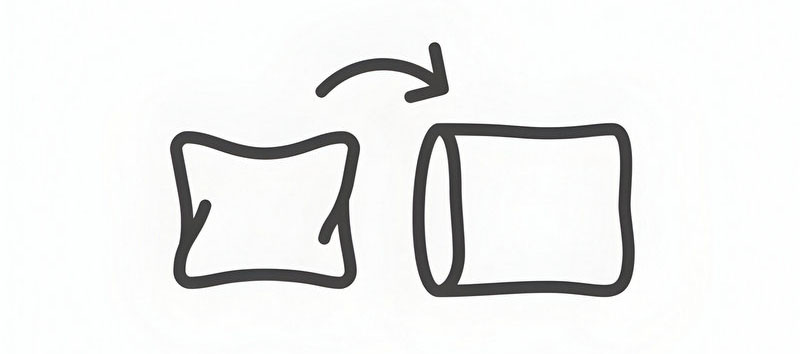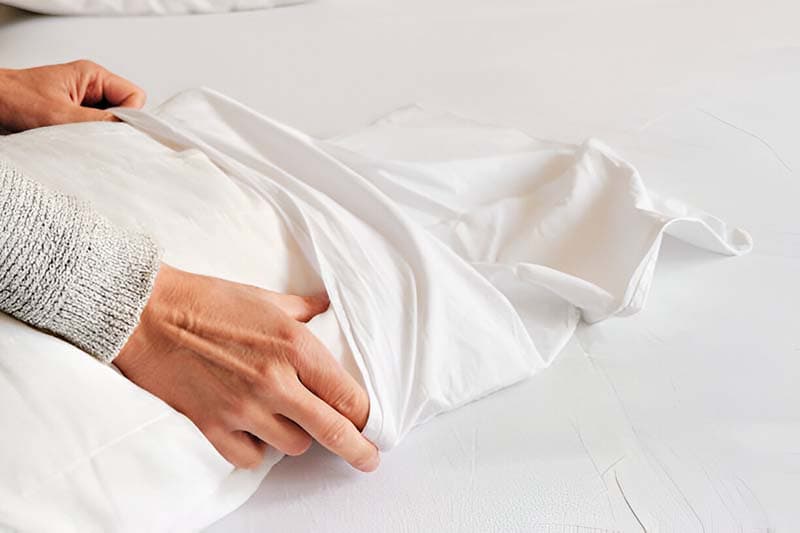You must have heard that pillowcase cleanliness is a significant factor in creating a healthy sleep environment. To maintain hygiene, you need to keep your pillowcases clean, not just for aesthetics but also for a hygienic place to sleep at night.
Pillowcases become the center of accumulating oil, sweat, and dust, so it is highly recommended to wash them often to prevent the build-up of dirt and allergens. Keeping your pillowcases clean can also prevent them from becoming worn out and torn due to the abrasive action of dust and other debris.
For clean pillowcases, cleaning techniques suitable for the type of fabric and the particular stains are essential. Whether dealing with grease stains or yellowing, proper care can significantly affect how your bedding looks and feels. Let’s learn how to clean white pillowcases properly.
Here’s how you clean different types of pillow cases:
Steps to Clean an Organic Cotton Pillowcase

Things You Need
- Mild laundry detergent
- Baking soda (optional for stains)
- White vinegar (optional for brightening)
- Dryer or clothesline
Let’s get started…
Step 1:
Before washing, check the care label on the pillowcase for specific instructions. Cotton pillowcases are generally safe for machine washing, though it's wise to note any particular recommendations about temperature or detergent to ensure the best care.
Step 2:
Be sure to separate the pillowcases from other laundry items before washing to prevent tangling or possible damage during the wash cycle.
Step 3:
If you notice stains, such as grease spots or yellowing, take a moment to spot-treat them before washing. Sprinkle a bit of baking soda on the stained areas, then gently dab with a mixture of water and vinegar. Allow it to sit for 10-15 minutes before moving to the wash.
Step 4:
Put the pillowcases in the washing machine. Use cool or warm water on the gentle cycle (if the care label allows it). A small amount of mild detergent should be added. Besides, add a small amount of vinegar to the rinse cycle to brighten white pillowcases.
Step 5:
Remove the pillowcases promptly from the washer after the wash cycle. Shake them out to minimize wrinkles, then place them in the dryer. Low heat is the right setting for this. Alternatively, if the weather is nice, you can hang them on a clothesline to air dry.
After drying, you can iron them on medium heat if you like a crisp, wrinkle-free effect. This step is optional but can give your pillowcases a polished finish.
Steps to Clean a Silk Pillowcase
Here’s how to wash silk pillowcases:
Things you need:
Mild detergent: Choose a gentle detergent suitable for delicate fabrics.
Cold water: Use cold water to prevent shrinking or damaging the silk fibers.
Clean the sink: To soak and wash the pillowcase.
Sponge: For spot cleaning, if necessary.
Towel: To absorb excess water after washing.
Flat drying surface: Preferably a clean towel or drying rack.
Steps to Clean a Silk Pillowcase
Read the care label on the silk pillowcase for specific instructions. Some silk may require dry cleaning only.
Spot cleaning
- If there are minor stains, spot clean with a mixture of cold water and a mild detergent.
- Gently dab the stain with a soft cloth or sponge. Avoid rubbing vigorously to prevent damaging the silk fibers.
Prepare for washing
- Fill a basin or sink with cold water. Avoid hot water, as it can damage silk.
- Add a small amount of mild detergent to the water.
- Use a detergent specifically formulated for delicate fabrics or silk.
Wash the pillowcase
- Submerge the pillowcase in the soapy water.
- Gently swish it around to ensure the detergent is evenly distributed.
- Let the pillowcase soak for no more than 5 minutes.
Rinse
- Drain the soapy water and refill the basin or sink with cold water.
- Rinse the pillowcase thoroughly until all detergent is removed.
- Avoid twisting or wringing the silk.
Remove excess water
- Lay the pillowcase flat on a clean towel.
- In order to remove any excess water, roll the towel with the pillowcase into it.
- Press it down gently so it can absorb the excess water.
Drying
- Lay the pillowcase flat on a drying rack or another clean, dry towel where it can be away from direct sunlight or the heater, heat source, etc.
- The pillowcase can be reshaped into the proper shape while still damp.
Additional Tips
- Washing a silk pillowcase 1-2 times a month is good to help keep them clean.
- Do not use bleach or a harsh detergent on silk.
- Do NOT put it in the dryer because heat will warp and damage silk fabric and fibres.
Dos and Don’ts of Washing a Pillowcases
Do's:
- Adhere to the care instructions on the label.
- Wash pillow cases every one to two weeks.
- Use a gentle detergent.
- Wash with other pillowcase items.
- Pre-treat stains prior to washing.
- Wash in cold or warm water.
Don'ts:
- Avoid washing in hot water unless the care instructions show it's allowed.
- Avoid overloading the washer.
- Avoid using bleach unless necessary.
- Remember to empty your pockets before washing.
- Do conduct regular cleaning, quarterly checks can work.
- Avoid drying on high heat.
- Make sure to complete regular cleaning.
- Avoid drying on high heat.
In What Ways Does a Dirty Pillowcase Influence You?
So, how does a dirty pillowcase influence you? Let's take a closer look at how sleeping in a dirty pillowcase could affect you.
Skin Issues
A dirty pillowcase can easily transfer dirt, oils and bacteria to your face, which could clog your pores, trigger acne, or even exacerbate existing skin conditions.
Allergies
A dirty pillowcase may be a hot-spot for dust mites and other allergens that could trigger allergies and/or respiratory issues.
Hair Problems
Dirt and oils accumulated on a pillowcase could also transfer to your hair, making it greasy-looking and causing scalp issues.
Sleep Quality
A dirty pillowcase may feel less comfortable and/or less clean and may make it difficult for you to relax and get a good night's sleep.
How Often Should you Disinfect/Clean your Pillowcases?
Your pillowcases should be washed and disinfected regularly. A good starting point is to clean your pillowcases every 1-2 weeks to remove sweat, oils, and dead skin cells that accumulate over time.
If you are ill, changing and washing the pillowcase every 2-3 days is a best practice to prevent germs from proliferating and to keep your sleeping environment sanitary.
Having a pillow protector underneath your pillowcase can also provide padding and help extend the time between cleaning pillowcases; however, to ensure your pillowcases are clean for your face and body use, they should regularly be washed.
Final Thoughts
Having fresh pillowcases is not only important for appearance, but also for a healthy sleep environment. Washing pillowcases 1-2 weeks ensures that sweat, oils, and dead skin cells do not build up, which prevents the over-accumulation of allergens that can irritate your skin.
If you have side sleeper pillowcases, for example, you want to ensure that they remain clean to support your side sleeper pillow and have manageable comfort, yet they also need to be cleaned and maintained. Your pillowcases can last for years if you wash them with mild detergents, avoid high temperatures, and dry them completely before putting them back on your pillows.
With just a few days of care, your pillowcases can continue to provide a fresh experience every night. Better yet, bedding that is cared for and well taken care can directly impact your well-being.























